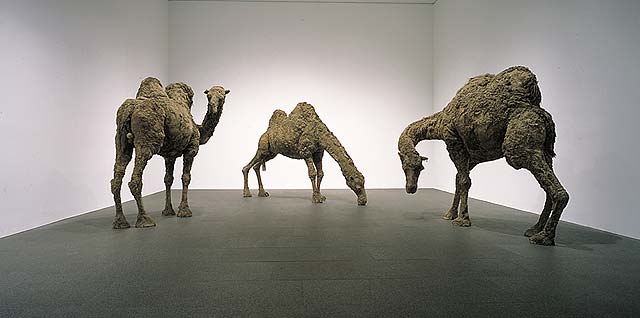Pleistocene Skeleton
Steel, wax, marble dust, and acrylic
Nancy Graves, 1970
Smithsonian Museum of American Art
Last fall I visited the newly renovated Smithsonian Museum of American Art. One of my favorite pieces was this sculpture by Nancy Graves. It’s made of steel, but coated and painted to resemble excavated bone.
It’s hard to explain why I singled this piece out – after all, it resembles any old skeleton in any number of natural history museums. But unlike the typical frenzied, kid-thronged dinosaur exhibit, the Graves sculpture was alone, at one end of a completely vacant gallery (except for myself and one of the Smithsonian’s many silent guards). It felt like I was discovering something for the first time. Yet it wasn’t authentic. It was neither “pleistocene” nor a “skeleton.” It had never been alive, and it wasn’t a history of anything, except the artist’s own imagination.
Pleistocene Skeleton
Steel, wax, marble dust, and acrylic
Nancy Graves, 1970
Smithsonian Museum of American Art
Apparently Graves’ contemporaries weren’t sure what to make of her work either. They knew she was good: in 1969, at the age of 28, she held a solo show at the Whitney (the first woman to do so). It consisted of three life-sized camels – built from the inside out, of acrylic, hair, wool, and paint over wood and steel armatures. According to the Time review,
More than a few museumgoers suspected that Nancy Graves’ camels were part of an ingenious put-on, particularly since the Whitney was handing out extraordinarily pretentious brochures in which Miss Graves was quoted as proclaiming that “these camels do not find their organization in the real world but are the result of my experience. I cannot imagine or perceive a camel until it is completed.” It sounded rather as though she were kidding the highbrows who insist that great art must be abstract. Since the abstract artist—by definition—depicts shapes for which no exact models exist in the visible world, he sometimes refers to his work as “not perceived until completed.”
Miss Graves, however, when approached directly, maintains that all she cares about is camels. “There’s as much possibility for fresh invention in making a camel as in making a human figure,” she says. Come to think of it, since nobody else has done much using the camel as a subject, there is probably more. (Time, “The Camel As Art,” 1969)

Camel VI, VII, VIII
wood, steel, burlap, polyurethane, animal skin, wax, oil paint
Nancy Graves, 1968-69
Graves worked continuously until her death in 1995, and her output was bewilderingly diverse. Prior to encountering “Pleistocene Skeleton,” I had never seen her earliest pieces. Her sculptures from the eighties look radically different – brightly colored abstract assemblages hardly reminiscent of natural history museums. So I was surprised to discover that one of her key influences was Clemente Susini, whose work she encountered at La Specola while on a Fulbright. (See my previous post on Susini here).
From an interview between Graves and Emily Wasserman:
The Museum of Natural History in Florence, Italy (where I lived and worked during 1966) contains the wax-works of an 18th-century anatomist, named Susini. What I saw there was a man whose total obsession was circumscribed within a very academic situation. That is, he was trying to define human anatomy in terms of drawings, and their reproduction in wax. The results were art, even in terms of that socio-historical period, although they were not recognized as such–they were not just copied cadavers. Visually, it’s the most emphatic thing–the attempt to be rigorous about whatever the problem was, was much more thorough and complete than most artists usually are…the significance of this for me was that Susini had produced a complex body of work from a single point of origin. (Artforum, 1970)
I love Graves’ description of Susini’s work. It reflects the central tension in scientific art (or art inspired by science) between accuracy and interpretation. Is it art or not? And why? “Pleistocene Skeleton” invokes that question, but doesn’t answer it.
Graves would continue to draw from natural history throughout her career. The fossil theme continues in her sculptures “Variability of Similar Forms,” “Fossils Incorrectly Placed,” and “Inside-Outside;” she would also create paintings based on geologic maps of the sea, moon, and Mars, and even her abstract sculptures included casts of natural materials. According to Michael Brenson, “while late American modernists were trying to build toward a future that would erase the past, Ms. Graves was involved in a wilder artistic project no less radical in its implications. She was re-creating evolution” (NYT, “Sculptures by Nancy Graves at the Brooklyn Museum,” 1987).
More on Nancy Graves:
Nancy Graves Foundation
National Gallery
Article at Answers.com

Sometimes looking back at an artist’s oeuvre brings forth so much more new information and hidden nuances. Glad you wrote this piece on Miss Nancy Graves. We will be sure to check out her art on our next visit to the Smithsonian…
Wow.. great post. And so well researched!
It would be interesting to see a reconstruction. It appears to be a camel designed by committee. Cool work!
Zeladoniac: I agree – I think the skeleton is a bit more convincing than the fully realized camel. I’m not sure if the purpose was to be convincingly real, or just disturbingly close. But it’s certainly cool.